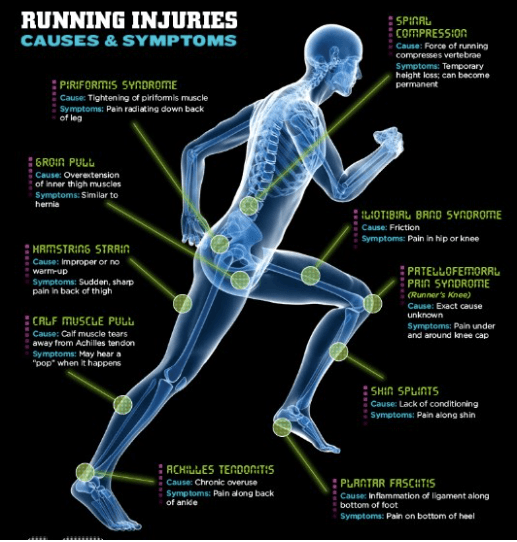
Running form, common injuries, exercises to improve running, and what to know about running shoes.
With as many as 55.9 million people reporting running as a form of exercise in the country, it is imperative to know the form most associated with increased efficiency and decreasing number of injuries as well as common exercises to complete as a runner to improve performance and further decrease risk of injuries. Let’s also not forget to consider what shoe options are available.
Proper Form
In regards to running and for the sake of this blog, we will focus on long distance running (jogging pace). Some simple tips to improve running efficiency, decreasing energy expenditure, and decreasing risk for injuries are as follows:
- Engage your core with limited pelvisrotaton as to not waste unnecessary energy
- Maintain a forward gaze (prevent your head from looking downward)
- Draw your shoulders back and down (leading with your chest)
- Keep your arms relaxed with a reciprocal swing not to cross in front of your body
- Elbows flexed at 90 degrees roughly
- Hands/wrists relaxed
- Hips pointing forward

In addition, focus on keeping your legs beneath your body by avoiding heel strike and landing with your midfoot. This will allow for proper knee bending and optimize stride length. F2inally, try to maintain a neutral foot position with slight pronation (avoid excessive outward foot rotation).
Common injuries associated with running and ways to decrease risk:
Injuries most commonly seen with running are:
- Low back pain
- IT band syndrome
- Runners Knee
- Shin splints
- Achilles tendonitis
- Calf strains
- Plantar fascitis

All of these are injuries that can be minimized and preventable with common practices such as exercise, stretching, and recovery modalities. A dynamic warmup prior to your run as well as general lower body stretching (hamstrings, calves, piriformis, TFL, glutes, tibialis anterior, and plantar fascia) following activity has been shown to decrease risk of injuries. Exercises and mobility activities to target hamstrings, hips, ankles, core and knees are shown to correlate with increased performance and decreased rate of injury. Some exercise examples are glute bridges, single leg (SL) balance/squat activities, planks/side planks, and many more. As with any activity, general safe practices are to listen to your body and progress your runs slowly; gradually increase your duration, intensity, and frequency. Allow for adequate rest in between to promote recovery and stay hydrated.
Shoes
As a car is only as good as its tires, a runner is only as good as their shoes. With that being said, there is no shoe that is necessarily best as it depends on the person. When choosing a shoe that works best for you. You want a lightweight shoe with adequate support, however not too much cushioning as this will change the way you run. You want a shoe that allows for proper foot/toe flexion and places your foot into a neutral position with slight pronation. If you are an overpronator, you want to consider a shoe that is designed to decrease that or consider orthotics.
There are arguments out there that suggest more of a minimalist style shoe or barefoot style running because it decreases stride length, increasing cadence, and promotes softer foot landing, however this can all be achieved with being attentive to your running form. More importantly, you have to allow for a break-in period and gradually wear for longer periods of time and then replace shoes after 300-400 miles of use. Pay attention to what your foot is telling you; if you are experiencing pain or discomfort, there is most likely a reason behind this and you shouldn’t neglect it.
To conclude, running is a popular and fun activity. These are all things that we should be conscientious of: proper form, injuries associated with running, common exercises/stretcing/mobility activites, and beneficial information regarding shoewear. Having knowledge of these things will promote longer lasting, injury free performance of running for the long haul. If you are experiencing pain or suffer from an injury, seek a physical therapist today to help guide you in the right direction. Now let’s get out there and run!

